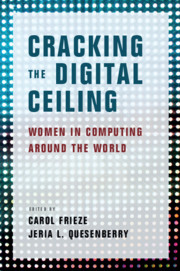Book contents
- Cracking the Digital Ceiling
- Cracking the Digital Ceiling
- Copyright page
- Contents
- Contributors
- Acknowledgments
- Introduction
- Part I Global Perspectives
- Part II Regional Perspectives
- Part III Cultural Perspectives from the United States and Europe
- 7 Against All Odds
- 8 Cultures and Context in Tech
- 9 Perspectives of Women with Disabilities in Computing
- 10 An Interview with Dr. Sue Black, OBE, Computer Scientist and Computing Evangelist
- 11 An Overview of the Swedish Educational System with a Focus on Women in Computer Science
- 12 Portugal
- 13 Women in Computing
- Part IV Cultural Perspectives from Asia-Pacific
- Conclusion
- Notes
- Index
- References
9 - Perspectives of Women with Disabilities in Computing
from Part III - Cultural Perspectives from the United States and Europe
Published online by Cambridge University Press: 10 October 2019
- Cracking the Digital Ceiling
- Cracking the Digital Ceiling
- Copyright page
- Contents
- Contributors
- Acknowledgments
- Introduction
- Part I Global Perspectives
- Part II Regional Perspectives
- Part III Cultural Perspectives from the United States and Europe
- 7 Against All Odds
- 8 Cultures and Context in Tech
- 9 Perspectives of Women with Disabilities in Computing
- 10 An Interview with Dr. Sue Black, OBE, Computer Scientist and Computing Evangelist
- 11 An Overview of the Swedish Educational System with a Focus on Women in Computer Science
- 12 Portugal
- 13 Women in Computing
- Part IV Cultural Perspectives from Asia-Pacific
- Conclusion
- Notes
- Index
- References
Summary
Popular media has recently given attention to sexist workplace culture and low rates of female employees within large tech companies. Tech companies have released a plethora of diversity reports as part of a commitment to diversifying the workforce. Disability is largely absent from these companies’ PR and resulting media coverage. Diversity and inclusion efforts – whether it is diversity reports to increase transparency, flexible benefits, or feminist stances meant to welcome women – rarely include disability specifically. When TechCrunch asked seven major companies – Intel, Apple, Twitter, Facebook, Slack, Google, and Salesforce – about the omission of disability from these reports, their responses were not reassuring (O’Hear, 2016). Facebook, Salesforce, and Google failed to respond. Intel and Slack pointed to their inclusion efforts related to disability and indicated they could release data in the future. Apple and Twitter pointed the journalist to their accessible products as evidence that they consider disability in driving innovation. Subsequently, Slack’s 2017 diversity report highlighted that 1.7% of their employees identify as having a disability (Slack Team, 2017). In 2016 LinkedIn included disability in their diversity reporting, highlighting that 3% of their US employees have a disability (Wadors, 2016). Otherwise, there is little attention given to individuals with disabilities, and, more specifically, women with disabilities in computing.
- Type
- Chapter
- Information
- Cracking the Digital CeilingWomen in Computing around the World, pp. 159 - 182Publisher: Cambridge University PressPrint publication year: 2019
References
- 2
- Cited by



